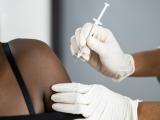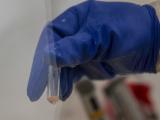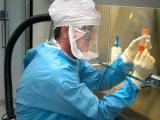Oct 18, 2011 (CIDRAP News) – If someone tried to kill Americans with Bacillus anthracis spores today, the nation would have a better medical tool chest for treating the sick and those potentially exposed than it had 10 years ago, when the anthrax letter attacks killed five people, but anthrax defenses are still a work in progress.
In the event of an anthrax attack, federal response plans call for treating those at risk with a 60-day regimen of antibiotics, and also for offering three doses of anthrax vaccine for longer-term protection against the risk of late-germinating B anthracis spores.
The government has enough doses of antibiotics in its civilian stockpile to treat 60 million people for the recommended 60 days, according to a report released last week by the WMD Terrorism Research Center, a nonprofit group headed by two former US senators. US Department of Health and Human Services (HHS) officials won't disclose the amounts of materials in the Strategic National Stockpile (SNS), citing national security concerns.
The SNS also contains enough doses of anthrax vaccine—the same one that was in use in 2001—to protect a few million people, according to the WMD Center report. Meanwhile, several companies are working on second-generation vaccines with the aim of providing protection with fewer doses at less cost, but their availability is still several years away.
The government also has something it didn't have 10 years ago: a supply of antitoxins—anthrax immune globulin (AIG) and other antibody products—that could be used to treat people with anthrax infections potentially too far advanced for successful antibiotic therapy. None of these have yet been approved by the Food and Drug Administration (FDA), but they can be used under emergency authorizations if needed, federal officials say. One of them was used in a man who was treated in Minnesota for inhalational anthrax in August.
Antibiotics as first defense
It was 10 years ago this month that letters containing B anthracis spores were mailed to US senators' offices and several media offices, sickening 22 people; 11 of them had inhalational anthrax, and five of those patients died. Besides spreading an extra layer of fear in the wake of the Sep 11 attacks, the anthrax assault disrupted the postal system and led to prolonged and highly expensive cleanup efforts in the affected buildings, including the Hart Senate Office building.
In the wake of the attacks, health officials recommended the 60-day course of antibiotics for about 10,000 potentially exposed people, most of them postal workers. At the postal processing center in Washington, DC, 2,000 workers were included in the recommendation. A Centers for Disease Control and Prevention (CDC) survey later showed that 40% of those workers took the full course of drugs, but another 45% stopped taking them because of side effects and other concerns. The recommended drugs include ciprofloxacin or doxycycline for adults and children, according to the CDC.
A three-dose course of the anthrax vaccine was also offered to several thousand people at the time, because of a theoretical risk that anthrax spores could linger in the body and germinate after the end of the antibiotic regimen. Few people accepted the offer, however.
Since the attacks, HHS has amassed enough antibiotics in the SNS to provide 60 days of treatment for 60 million people, according to the WMD Center report. Still, the report's general verdict was that the nation has an adequate supply of medical countermeasures to blunt "small-scale attacks" with anthrax or several other likely pathogens but possibly not enough for a large-scale attack.
Building the vaccine stockpile
At one time, HHS officials talked of buying enough doses of anthrax vaccine to protect 75 million people in the wake of an attack, or at least that was the goal of a contract awarded in 2004 for a second-generation vaccine. But now officials won't specify their goal for the stockpile. However, the WMD Center report said that the stockpile contains enough doses to protect 4.4 million people and that another 6.3 vaccine courses are on order.
The licensed anthrax vaccine is BioThrax (also called Anthrax Vaccine Adsorbed, or AVA), which was licensed in 1970 and is made by Maryland-based Emergent BioSolutions. Since 1998, the injection has been given to more than 2.5 million US military members serving in high-risk regions such as the Middle East, according to Emergent. In the past it required six doses plus annual boosters to be considered fully protective, but in 2009 the Advisory Committee on Immunization Practices (ACIP) changed the protocol to five doses plus annual boosters.
At the same time, the ACIP changed the vaccination route from subcutaneous to intramuscular. This change has decreased adverse reactions to the vaccine while providing the same immunogenicity, officials with HHS's Biomedical Advanced Research and Development Authority (BARDA) told CIDRAP News in e-mail responses to questions.
Although a full course of the vaccine for preexposure use is five doses, the CDC recommends three doses for postexposure use, such as in a bioterrorist attack. The vaccine is not licensed for postexposure use, so it would have to be done under "investigational new drug" (IND) rules, according to the CDC. BARDA officials said Emergent has submitted to the FDA a set of data that, if approved, would permit postexposure use of the vaccine under an emergency use authorization (EUA) rather than under IND rules.
Since 2005, BARDA and the CDC have spent about $1.2 billion on BioThrax for postexposure use, BARDA officials said. That includes $505 million from the CDC and $691 million from BARDA, with the latter covering some development activities, such as studies leading to FDA approval of a 4-year shelf life for the vaccine.
BARDA said it is also working to determine if the BioThrax stockpile can be stretched by reducing the number of doses or the antigen amount in each dose. Along with the National Institute of Allergy and Infectious Diseases (NIAID) and the CDC, the agency is supporting trials of a two-dose regimen and a three-dose regimen with half the standard antigen amount.
"These studies are expected to inform the use of the product after an incident under EUA and to expand the current anthrax vaccine stockpile multifold," the BARDA statement said. In addition, BARDA and the NIAID are funding studies to determine if adjuvants can be used to stretch the stockpile.
Other efforts include extending the shelf life of the vaccine, according to BARDA. In 2007 the Government Accountability Office (GAO) said stockpiled anthrax vaccine was being wasted because of expiration. With BARDA funding, Emergent persuaded the FDA to extend the vaccine's expiration date once, to 4 years, and the company is now compiling data to support a request to extend it to 5 years, BARDA said.
CDC spokesman Von Roebuck said that in recognition of potential efficiencies cited in the GAO report, the CDC now participates in an anthrax vaccine inventory sharing program with the Department of Defense (DoD) (which vaccinates soldiers on an ongoing basis). As part of this, doses in the civilian stockpile are rotated to the DoD before expiration, reducing the number that have to be destroyed.
Still another concern about BioThrax focuses not on the supply but on who can be vaccinated. The National Biodefense Science Board (NBSB), which advises HHS on biodefense issues, is currently pondering the problem that there have been no studies of the vaccine's safety or immunogenicity in children.
"The question is, how do you determine the vaccine use in a group of people that the vaccine has never been given to or studied in?" said Dr. Patricia Quinlisk, chair of the NBSB and state epidemiologist in the Iowa Department of Health. At a meeting later this month, the NBSB is expected to make a recommendation to HHS on what to do about that knowledge gap.
Next-generation vaccines
While BioThrax is considered safe and effective, its drawbacks include the high number of doses required, a history of a relatively high rate of adverse events, and, according to reports in the medical literature, difficulty in manufacturing. Consequently, efforts to develop better vaccines have been under way for years. Several companies continue to work on second-generation vaccines, but BARDA says their availability remains years away.
Second-generation vaccine efforts have focused mainly on using recombinant forms of protective antigen (rPA), a component of the anthrax toxin. The existing vaccine, in comparison, contains a mix of components filtered from cultures of an attenuated strain of B anthracis, according to a 2009 review in Trends in Microbiology.
The first major push by HHS to bring a second-generation vaccine to fruition famously stumbled in 2006. VaxGen, a small California company, won an $877 million HHS contract in 2004 to produce 75 million doses of an rPA vaccine. But the vaccine proved to be unstable. After VaxGen missed a deadline for starting a clinical trial, HHS canceled the contract in December 2006. VaxGen sold the vaccine to Emergent BioSolutions in 2008.
Emergent and another company, PharmAthene, are working on rPA vaccines under BARDA contracts, following earlier progress in development with support from the National Institutes of Health and DoD. BARDA said both companies have made changes in their manufacturing process to improve the vaccines' stability. "However, these changes may require new dose-finding clinical trials to demonstrate safety and immunogenicity," the BARDA statement said. "Key meetings between both companies and the FDA later this year will impact the respective courses of vaccine development for both vaccine candidates."
Philip K. Russell, PhD, a retired vaccinologist who was a senior biodefense official in the George W. Bush administration, criticized the pace of second-generation vaccine development as too slow. "The recombinant PA vaccine I think is at least 3 years behind where it should be," he told CIDRAP News.
"I think the failure of VaxGen to launch a phase 2 trial due to instability created a problem, and rather than try to help them fix the problem, they canceled the contract," even though help could have been provided at little cost to the government, Russell said. "Then the development of similar products by PharmAthene and Emergent has been agonizingly slow. Part of it is because of the management of the contracts by the federal government. . . . I guess in the interest of not making any mistakes they haven't allowed the companies to move as fast as they could have."
BARDA officials, when asked to comment on Russell's critique, said they decided to withdraw the solicitation for procurement of a next-generation anthrax vaccine in December 2009 on the basis of their assessment that none of the responding companies had product candidates that could be licensed within 8 years, as mandated by the Project BioShield Act.
"Subsequently the Offerors [companies] were supported for advanced development of their respective vaccine candidates," BARDA said. "Over the past two years, this assessment has borne out correctly, as these candidates are in early stage development and many years away from possible acquisition and licensure, if remaining technical and manufacturing process hurdles can be crossed."
PharmAthene, based in Annapolis, Md., ran into problems with HHS requirements after it bought an rPA vaccine from the British firm Avecia in 2008, according to Francesca Cook, the company's vice president for policy and government affairs. At the time, the vaccine had already entered phase 2 trials, and "we were about 4-and-a-half to 5 years away from a product we thought could meet EUA requirements and be delivered into the stockpile," she said.
But in negotiations with BARDA for a long-term development and procurement contract, the agency required that PharmAthene move the manufacturing of the vaccine from the United Kingdom to the United States, a process that took years, Cook said. In addition, BARDA advised the company not to use vaccine made at the British facility in its testing program, which also caused delays, she reported.
"The technology transfer was completed this summer, and now we're scaling up the process," Cook said. "We're kind of at the phase 2 level. So we're looking now at the 2016-17 time frame [for delivering the vaccine]."
BARDA, in responding to a query about Cook's comments, said manufacturing of the vaccine candidate "was brought from a UK manufacturer to a US third-party manufacturer to remediate significant quality and technical problems that were noted in the UK manufacturer by the FDA and BARDA in 2008-2009. The manufacturing process for this vaccine candidate has been changed significantly so FDA is reviewing the data to determine whether the product produced in the UK and in the US are comparable. If not, clinical studies and product stability studies with the product candidate manufactured in the US will be needed."
Meanwhile, hedging its bets, BARDA noted that it is supporting the development of two newer rPA anthrax vaccine candidates. In July 2010 the agency awarded a contract to Pfenex to develop an rPA vaccine using the bacterium Pseudomonas fluorescens to produce the antigen. And last month BARDA awarded a contract to Vaxin to develop a vaccine that uses an adenovirus vector and would be administered intranasally.
Antitoxins now available
Appropriate antibiotics can clear B anthracis in patients sick with inhalational anthrax, but if the pathogen has already released its toxin into the bloodstream, patients can remain severely sick and in danger of dying. That's what happened to a Florida man who was treated for the disease in a Minneapolis hospital in August after getting sick following a trip out west. He was hospitalized for 3 weeks and required mechanical ventilation.
The man's doctors obtained from the CDC a supply of AIG, derived from the serum of people who had received the anthrax vaccine, and used it along with other treatment measures. It wasn't clear whether the AIG was the decisive factor, but the patient recovered.
HHS so far has acquired supplies of two antitoxins for anthrax and is supporting the development of others. As with the other countermeasures, officials won't disclose the size of the supply.
In 2006 the agency awarded a $143 million contract to Cangene, based in Winnipeg, Man., for 10,000 treatment courses of AIG, according to previous reports. BARDA officials said all those doses have since been delivered.
The same year, the agency awarded a $165 million contract to Human Genome Sciences (HGS) for 20,000 courses of a recombinant human monoclonal antibody called raxibacumab (ABthrax), as reported previously. BARDA officials said all the doses under that initial contract have been delivered, and in 2009 the agency decided to buy more, for delivery by 2012. They did not specify the amount.
HGS filed for FDA approval of raxibacumab in 2009, but the FDA responded with a request for more studies, according to BARDA. "HGS reported to BARDA that the company has completed the necessary studies and anticipates submitting the data to the FDA in April of 2012," the agency said. "If the FDA determines the data is sufficient, this will be the first product supported by Project Bioshield to become licensed."
In addition, Elusys Therapeutics has a BARDA contract to develop a monoclonal anthrax antitoxin that can be injected intramuscularly. "An intramuscular formulation has the potential to greatly improve response capabilities since the current formulations are given intravenously," the BARDA statement said. It said the product is lyophilized (freeze-dried), which will increase its shelf life, cut storage costs, and permit easier field use.
Of course, having supplies of antibiotics and other countermeasures doesn't guarantee that they could be quickly deployed in the event of an anthrax attack. But Quinlisk, chair of the NBSB, thinks the nation is better prepared on that front than it was 10 years ago.
"Trying to do a mass vaccination campaign here today would be much easier and better organized than it would've been 10 years ago," she said. "And I think that is true in every locality and state. I think that was seen during the H1N1 flu. We used a lot of the same systems and planning to deal with H1N1, and every time we do something like that, we learn more and get better at dealing with something somebody might deliberately try to do."
See also:
Oct 12 CIDRAP News story on WMD Center report
Sep 22 CIDRAP News story "HHS anthrax vaccine advisors weigh pediatric use"
2002 Emerg Infect Dis report on anthrax prophylaxis in postal workers
Abstract of 2009 Trends in Microbiology review on anthrax preparedness
CDC recommendations on postexposure prophylaxis for anthrax

















